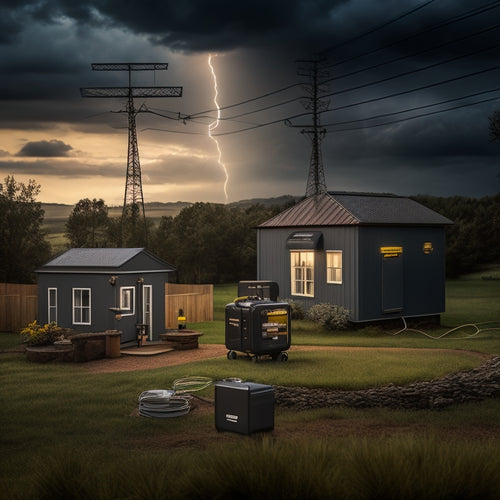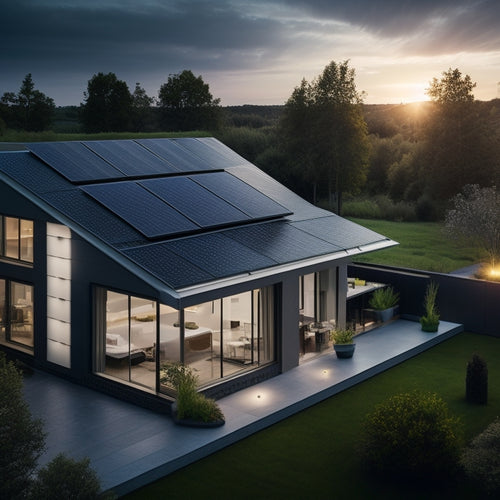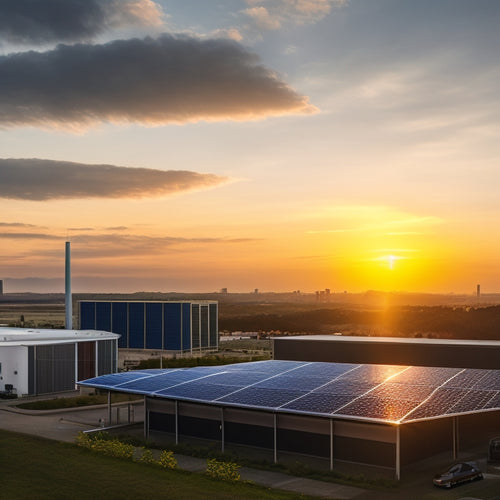
Farm Solar Panels
Share
By installing farm solar panels, you can reduce your reliance on external power sources by up to 100%, generating clean energy and greatly lowering your energy bills while contributing to a cleaner, more sustainable environment. You'll gain control over your power needs, enhancing your lifestyle and even increasing your property value by up to 17%. With high-efficiency bifacial cells, you can elevate energy output by up to 25% and maximize production per unit area. Verifying panel wattage is essential, and with proper maintenance, your solar panels can last over 30 years, providing a strong return on investment and setting the stage for a more sustainable farming future.
The Essentials
- Bifacial solar panels can increase energy output by up to 25% and enable dual-use farming practices, maximizing land potential and investment returns.
- Off-grid solar systems provide energy independence, reducing reliance on external power sources and enhancing lifestyle on farms.
- Solar panels can last over 30 years, offering a long-term, low-maintenance solution for renewable energy generation on farms.
- High-efficiency solar panels can reduce carbon footprint and increase energy production, contributing to sustainable farming practices and environmentally conscious initiatives.
- Installing solar panels on farms can increase property value by up to 17%, making them a valuable addition to agricultural operations.
Rural Energy Independence Matters
As you consider farm solar panels, you're likely thinking about achieving rural energy self-sufficiency, which means relying less on external power sources and more on renewable energy generated on your own land.
By utilizing solar power, you can reduce your reliance on fossil fuels and mitigate the risks associated with fluctuating energy prices.
Furthermore, specialized farm solar panels can address the unique demands of farm operations, providing a reliable source of power despite frequent grid outages and limited access to traditional energy infrastructure Farm Energy Efficiency.
Rural Energy Self-Sufficiency
By the dawn of the 21st century, rural areas had already begun to recognize the importance of energy self-sufficiency. You're not alone in seeking freedom from reliance on external energy sources.
Rural energy self-sufficiency is about taking control of your power needs, reducing your carbon footprint, and increasing energy autonomy. Many are turning to off-grid solar power systems to achieve this goal, which can provide a seamless shift to off-grid energy independence renewable energy solutions.
Investing in solar panels is a vital step towards achieving energy autonomy. You can generate your own clean energy, reducing your reliance on the grid and lowering your energy bills. A well-designed solar investment can provide a significant portion of your energy needs, giving you greater control over your energy future.
Rural energy self-sufficiency isn't just about saving money; it's about having the freedom to live life on your own terms. With solar panels, you're less vulnerable to price hikes and grid outages.
You're also contributing to a cleaner, more sustainable environment. By embracing rural energy self-sufficiency, you're taking a significant step towards a more independent and self-reliant lifestyle.
Renewable Power Sources
While fossil fuels continue to dominate the energy landscape, rural residents are increasingly turning to renewable power sources to attain energy independence. You're likely no exception, considering the benefits of farm solar panels and other renewable energy sources.
Renewable power sources, such as solar, wind, and hydro, offer a cleaner and more sustainable alternative to traditional energy sources. By breaking free from the constraints of traditional energy sources with an off-grid solar kit, you can enjoy the peace of mind that comes with knowing you have control over your own power needs.
You can take advantage of solar incentives, participate in community projects, and reduce your environmental impact. Furthermore, advancements in energy storage and grid integration have made it possible to store excess energy and feed it back into the grid.
With lower maintenance costs and various funding opportunities, renewable power sources are becoming more accessible. As technology continues to advance, policy implications will play a significant role in shaping the future of renewable energy.
Stay ahead of the curve and investigate the future trends in renewable power sources to guarantee a sustainable and independent energy future for your farm.
Increases Property Value Fast
You'll find that installing farm solar panels greatly enhances your home's resale worth, making it more attractive to potential buyers.
In fact, with the increasing demand for eco-friendly homes, solar-powered properties are highly sought after.
Additionally, the land itself increases in value, as the solar panels become an important asset that can be sold or leased.
Boosts Home Resale Value
Installing farm solar panels greatly enhances home resale value, raising property value rapidly. This is because solar panels are a highly sought-after feature in today's real estate market. As you consider installing farm solar panels, you'll be pleased to know that they can considerably improve your home's resale value.
| Benefits | Description |
|---|---|
| Increased Property Value | Farm solar panels can increase your property value by up to 17% |
| Solar Incentives | You may be eligible for solar incentives, such as tax credits and rebates |
| Property Improvements | Solar panels are a desirable feature that can attract more buyers and increase your home's selling price |
Raises Land Worth Fast
The installation of farm solar panels not only enhances your home's resale value but also increases your land worth rapidly.
This is because solar panels are a prized asset that can appreciate your land's value over time.
As a result, you can benefit from land appreciation, which can lead to a significant increase in your property's value.
High-Efficiency Bifacial Cells
You'll benefit from high-efficiency bifacial cells in your farm solar panels, which can enhance your energy output by up to 25% compared to traditional monofacial cells.
By utilizing energy from both the front and back sides of the panel, bifacial cells maximize energy production per unit area, making them an ideal choice for renewable energy systems that require sustainable power solutions.
With the ability to generate more power from the same land area, you can reduce your carbon footprint and increase your return on investment.
This means you can generate more power while reducing the land required for your solar farm.
Boosting Energy Output
About 20-30% more energy can be generated from the same land area by incorporating high-efficiency bifacial cells into your farm solar panels. This significant enhancement in energy output is due to the cells' ability to capture energy from both the front and back sides of the panel.
By doing so, you can increase your overall energy production without requiring more land.
As you consider integrating high-efficiency bifacial cells into your farm solar panels, you'll want to think about energy storage as well. Since you'll be generating more energy, you'll need a reliable way to store it for later use. This could include investing in advanced battery systems or other energy storage solutions.
In addition to the obvious energy benefits, high-efficiency bifacial cells can also provide agricultural benefits. By using the space beneath the panels for crops or grazing, you can create a thriving agricultural ecosystem that coexists with your solar farm.
This dual-use approach can help you maximize your land's potential and increase your returns on investment.
Reducing Land Use
Reducing Land Use
By deploying high-efficiency bifacial cells in your farm solar panels, you're effectively freeing up more land for other purposes, since the same energy output can be achieved with a smaller footprint. This reduction in land usage is a significant benefit, especially for farms that prioritize land conservation and sustainable agriculture.
With bifacial cells, you can allocate the newly available land for other uses, such as expanding crop production, creating habitats for wildlife, or even establishing natural buffers to protect nearby water sources.
High-efficiency bifacial cells can increase energy output by up to 25% compared to traditional monofacial cells. This means you can generate the same amount of energy with fewer panels, resulting in a smaller land requirement.
By optimizing your farm's energy production while minimizing land usage, you're taking an essential step towards a more sustainable and environmentally conscious farming practice.
Check Wattage Per Panel
You'll want to verify the wattage per panel to guarantee you're getting the desired panel power output. This metric indicates the maximum amount of energy each panel can produce under ideal conditions.
Residential solar energy storage systems like photovoltaic panels can greatly impact the overall energy production of your farm. By checking the wattage, you'll get a sense of the energy per unit area, which is essential for determining the number of panels needed for your farm's energy requirements.
Panel Power Output
When selecting farm solar panels, understanding the panel power output is essential to confirm your energy needs are met. You need to verify that the panels can generate enough power to support your farm's operations. Panel power output is measured in watts (W) and is determined by the panel's efficiency in converting sunlight into electrical energy.
| Panel Type | Panel Efficiency | Power Output (W) |
|---|---|---|
| Monocrystalline | 20% | 300-400 |
| Polycrystalline | 18% | 250-350 |
| Thin-Film | 12% | 150-250 |
As shown in the table, different types of panels have varying levels of efficiency and power output. Monocrystalline panels are the most efficient, followed by polycrystalline and thin-film panels. When choosing a panel, consider your energy requirements and the available space for installation. Higher-efficiency panels may be more expensive, but they can provide more power per unit area. By understanding panel power output, you can make an informed decision and confirm that your farm's energy needs are met.
Energy Per Unit
The energy per unit of a solar panel, typically measured in watts per panel, is a critical factor in determining the overall energy output of your farm's solar array. This metric directly influences the amount of electricity your farm can generate from sunlight.
When evaluating solar panels, you'll want to take into account the wattage per panel to ascertain you're getting the most energy-efficient option for your farm.
High-efficiency solar panels typically have higher wattage ratings, often ranging from 300 to 400 watts per panel. These panels are designed to maximize energy production, allowing you to generate more power from a smaller surface area.
By investing in high-efficiency solar technology, you can reduce the overall size of your solar array while still meeting your energy needs.
When checking the wattage per panel, look for solar panels with high energy efficiency ratings. A higher rating indicates that the panel can convert more sunlight into usable electricity.
Longer Lifespan Than Turbines
You'll find that solar panels on your farm can last longer than expected, with many systems still producing at 80% of their original capacity after 25 years.
In fact, some panels have been known to last up to 40 years or more.
This extended lifespan is a significant advantage over wind turbines, which typically need to be replaced after 15 to 20 years.
Last Longer Than Expected
Beyond their relatively low maintenance requirements, farm solar panels boast an unexpected advantage: they outlast their turbine counterparts by a significant margin.
You're likely to get 30 years or more of efficient energy production from your solar panels, with some lasting up to 40 years or more. This extended lifespan is a result of their durable design and low-stress operation.
In contrast, wind turbines typically last around 20-25 years before requiring replacement. This shorter lifespan is due to the high-stress environment in which turbines operate, with constant rotation and exposure to harsh weather conditions.
You can further extend the life of your solar panels by implementing effective maintenance strategies.
Regular cleaning and inspection can help identify potential issues before they become major problems. By keeping your panels in good condition, you'll guarantee they continue to generate clean energy for years to come, providing you with a reliable source of power and a strong return on investment.
Frequently Asked Questions
Can Farm Solar Panels Be Installed on Existing Barns and Buildings?
You can install solar panels on existing structures, and barn roof installation is a viable option, offering energy efficiency and independence, as long as the roof's condition and structural integrity can support the added weight and load.
Do Solar Panels Affect Wireless Signal Reception on Farms?
You've heard stories of rural homes with spotty wireless signals, like the Johnson's farm where a single solar panel array installation dropped their signal strength by 30%. Solar interference can indeed impact your wireless reception, so it's essential to assess and mitigate potential signal disruptions.
Are Farm Solar Panels Resistant to Hail and Extreme Weather?
You'll find that solar panels are designed with hail resistance and weather durability in mind, typically meeting or exceeding industry standards for withstanding extreme weather conditions, ensuring your renewable energy source remains reliable and efficient.
Can I Install Farm Solar Panels Myself to Save Money?
You're likely aware that 72% of homeowners DIY to save cash; however, when it comes to solar panel installation, it's essential to weigh the risks. While DIY installation is a cost-saving technique, it may void warranties and compromise system performance, ultimately offsetting potential savings.
Do Farm Solar Panels Require Regular Maintenance and Cleaning?
You'll need to perform regular maintenance and cleaning to guarantee ideal performance monitoring and energy efficiency, as dirt and debris can reduce energy output, but don't worry, it's a relatively simple process that'll give you control over your system's health.
Final Thoughts
As you weigh your options for rural energy independence, remember that farm solar panels are a smart investment. Not only do they increase your property value quickly, but high-efficiency bifacial cells also maximize energy production. Be certain to check the wattage per panel to guarantee you're getting the most bang for your buck. And let's be real, would you rather rely on noisy turbines or quiet, long-lasting solar panels? The answer is clear: farm solar panels are the way to go for a sustainable energy future.
Related Posts
-

Key Components of a Reliable Emergency Power Supply System
A reliable emergency power supply system requires several key components. You need proven performance metrics to guar...
-

Home Solar Battery
You're opting for a home solar battery that allows you to utilize the power of the sun during the day and use it at n...
-

Advantages of Commercial Solar Battery On-Site Storage
By investing in a commercial solar battery on-site storage system, you can greatly reduce your energy grid dependence...


